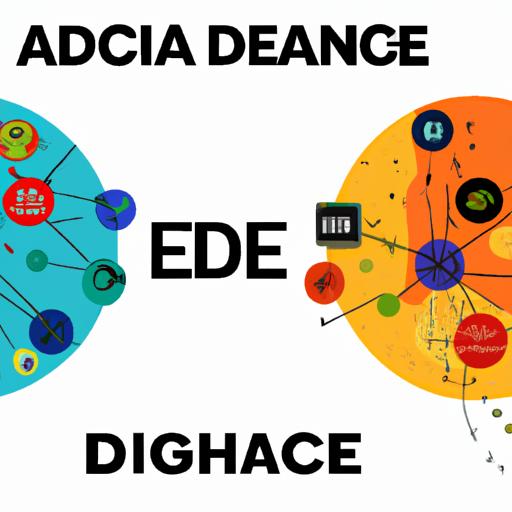
Introduction
In the vast world of digital advertising, terms like ad exchange and ad network are frequently thrown around, but do you truly understand what sets them apart? Let’s dive into the fundamental disparities between these two essential components of online advertising to navigate the complexities of the digital marketing landscape with confidence.
When we talk about ad exchanges, we are referring to platforms where advertisers and publishers come together in a real-time bidding environment. On the other hand, ad networks act as intermediaries that connect advertisers with a network of publishers to facilitate ad placements. Understanding the nuances between these two entities is crucial for optimizing your advertising strategies and maximizing your ROSo, buckle up as we unravel the intricacies of ad exchange versus ad network to empower you in making informed decisions for your digital marketing endeavors.
Understanding Ad Network
How Ad Networks Operate
Ad networks serve as the bridge between advertisers seeking to promote their products or services and publishers looking to monetize their online platforms. These networks aggregate ad inventory from various publishers and offer it to advertisers, enabling them to reach a broader audience. Ad networks leverage data and algorithms to match advertisements with relevant websites, ensuring maximum impact and engagement.
Benefits of Using Ad Networks for Advertisers and Publishers
For advertisers, ad networks provide access to a diverse range of websites and audiences, increasing the visibility of their ads and driving traffic to their websites. On the other hand, publishers benefit from ad networks by monetizing their online content through targeted advertisements, generating revenue based on ad impressions or clicks. Ad networks streamline the advertising process, offering a cost-effective and efficient solution for both advertisers and publishers.
Examples of Popular Ad Networks in the Market
Some well-known ad networks include Google AdSense, Media.net, and AdRoll. Google AdSense, for instance, enables website owners to display targeted ads on their platforms, while Media.net specializes in contextual advertising solutions. AdRoll focuses on retargeting strategies, helping advertisers reach potential customers who have previously interacted with their brand. These ad networks exemplify the diverse range of options available in the digital advertising ecosystem, catering to the specific needs and goals of advertisers and publishers alike.
Key Differences Between Ad Exchange and Ad Network
Pricing Model
When it comes to the pricing model, ad exchanges typically operate on a real-time bidding (RTB) system, where advertisers bid on ad impressions in an auction-style setup. This dynamic pricing mechanism allows for flexibility in ad pricing and enables advertisers to optimize their ad spend based on performance metrics. On the other hand, ad networks often offer fixed pricing models or negotiate rates directly with publishers, providing a more structured approach to ad placements.
Inventory Access
Ad exchanges provide access to a wide range of ad inventory from multiple publishers and websites, offering advertisers a diverse pool of ad placements to choose from. In contrast, ad networks have a curated network of publishers with whom they have established partnerships, limiting the scope of inventory available for advertisers. This difference in inventory access can impact the reach and targeting options available to advertisers on each platform.
Targeting Capabilities
Ad exchanges typically offer advanced targeting capabilities, allowing advertisers to segment their audience based on various criteria such as demographics, interests, and behavior. This granular targeting approach enables advertisers to reach specific audience segments with relevant ads, optimizing campaign performance. Ad networks may also offer targeting options, but they may be more limited compared to ad exchanges, depending on the network’s capabilities and partnerships.
Control Over Ad Placements
One significant difference between ad exchanges and ad networks is the level of control advertisers have over ad placements. Ad exchanges provide more transparency and control, allowing advertisers to select specific websites or placements for their ads. In contrast, ad networks may offer less control over ad placements, as advertisers rely on the network to match their ads with relevant publisher inventory. This difference in control can impact campaign performance and brand safety considerations for advertisers.
Which is Better: Ad Exchange or Ad Network?
Factors to Consider When Choosing
When faced with the decision of whether to utilize an ad exchange or an ad network for your advertising campaigns, it’s essential to consider several key factors. One crucial aspect to ponder is the pricing model offered by each platform. Ad exchanges typically operate on a real-time bidding system, allowing for greater flexibility and potentially lower costs compared to ad networks, which often have fixed pricing structures. Additionally, assess the level of control you desire over your ad placements. Ad exchanges provide more granular control, enabling you to target specific audiences and optimize your ad performance effectively.
Case Studies of Successful Campaigns
To shed light on the practical implications of choosing between ad exchanges and ad networks, let’s delve into some illuminating case studies. By examining real-world examples of successful campaigns, we can glean valuable insights into the strengths and weaknesses of each platform. From increased conversion rates to enhanced brand visibility, these case studies will showcase the impact of strategic decision-making when it comes to selecting the most suitable advertising platform for your unique needs. So, let’s embark on a journey through these case studies to uncover the secrets behind maximizing your advertising efforts in the digital realm.

